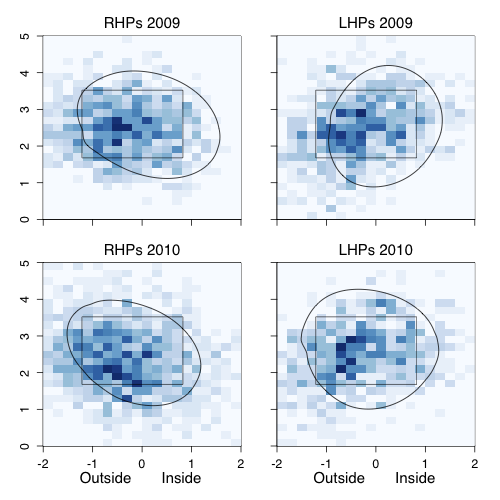
| F/X Visualizations | October 01, 2010 |
Earlier in the week I was looking at the AL WAR leader board I was taken aback by Robinson Cano's position. I knew he was having a good year, but not such a great one. Digging into it I saw he had nearly doubled his walk rate. It looks like someone else also took note and as I was planning this post on it I read Albert Lyu's FanGraphs piece. Here I will take a slightly different angle than Albert to present a complimentary picture of Cano's walk rate.
Like Albert I was struck by the fact that Cano had such a higher walk rate in spite of his higher 2010 Swing% (and especially for out-of-the-zone pitches: 37% this year compared to 31% last year). That is from FanGraphs who get the data from BIS. The pitchf/x data sees a similar, though not as extreme, increase from 32% to 34%.
So where are the extra walks coming from? Part of the reason is a slight drop in Contact%. As Albert points out, less contact obviously means more strikes (and thus more strikeouts), but it also makes at-bats last longer, potentially leading to more walks. But the biggest reason seems to be a drop in Zone%. The BIS numbers see a drop from 50% in 2009 to 43% in 2010; Pitchf/x saw 51% in the zone in 2009 and 44% in 2010.
This was my jumping off point: what is the difference in pitches Cano saw in 2010 compared to 2009, and what was the difference in which he swung at? To do that I took all the pitches he saw in 2009 and 2010, binned them, color-coded the bins by number of pitches (darker is more), and separated by year and pitcher handedness. On top of that I plotted Cano's 50% swing contour. Pitches inside the curve Cano swung at more often than not, while pitches outside the curve Cano took more often than not.

Looking first against RHPs you can see that there is a much greater spread of pitches in 2010 compared to 2009, with fewer pitches in the strike zone. Particularly he saw more pitches away and down. And even within the zone he saw more pitches in the bottom corner, which might not be called as strikes anyway because the zone is called more like an oval than a rectangle. His 50% swing contour against RHPs in 2010 is shifted slightly away and maybe a little bit smaller
Against LHPs again there are fewer pitches in the strike zone. But in this case Cano is clearly swinging more often, with his 50% swing contour almost entirely out of the rectangular zone.
These data suggest that a part of Cano's increased walk rate seems to be that he is seeing fewer pitches in the strike zone. This could be because of his better power numbers in 2009 and 2010 -- making pitchers wary of giving him good pitches to hit. Thus the walks seem to be as much a result of pitchers' changing approach to facing Cano as Cano's changing plate discipline. But either way they have come about, those walks, combined with his low K-rate and solid power at second base, make him a very valuable baseball player.